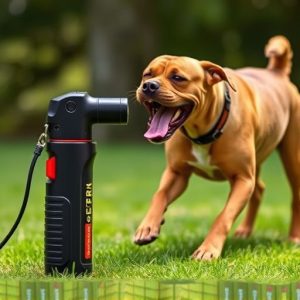Unveiling Optimal Range of Dog Pepper Spray: Ingredients & Best Practices
Mace dog spray, with capsaicin as its active ingredient, temporarily disorients aggressors by irrita…….
Mace dog spray, with capsaicin as its active ingredient, temporarily disorients aggressors by irritating their eyes and respiratory systems within an optimal range of 2-3 meters. Effectiveness is influenced by user technique, capsaicin concentration, environmental conditions (wind, temperature, humidity), aiming directly at the target, and using higher concentrations. To maximize safety and effectiveness, aim for the face and eyes at a 45-degree angle from 2–3 feet away, wear protective gear, shield from wind, and avoid cross-contamination.
“Uncover the power and precision of mace dog spray, a non-lethal self-defense tool designed to deter aggressive canines. This comprehensive guide explores the factors influencing the effective distance of dog pepper spray, ensuring users employ it safely and effectively. From understanding its active ingredients to mastering application techniques, learn how to maximize the optimal range of dog pepper spray for personal protection in various scenarios.”
- Understanding Mace Dog Spray and Its Active Ingredients
- Factors Affecting the Effective Distance of Dog Pepper Spray
- Best Practices for Optimal Range and Safety with Dog Pepper Spray
Understanding Mace Dog Spray and Its Active Ingredients
Mace dog spray, also known as pepper spray for dogs, is a non-lethal self-defense tool designed to temporarily incapacitate an aggressor. It works by irritating the eyes and respiratory system, causing the target to experience temporary blindness, coughing, and difficulty breathing. This disruption can provide enough time for the user to escape or seek help.
The effectiveness of dog pepper spray depends on several factors, including the optimal range at which it’s deployed. Many quality dog pepper sprays have an optimal range of around 2-3 meters (6-10 feet). Beyond this distance, the spray may not reach the aggressor effectively, rendering it less useful in self-defense scenarios. Active ingredients, such as capsaicin, play a crucial role in the spray’s potency and duration of effect, ensuring users have a reliable defense against potential threats from dogs.
Factors Affecting the Effective Distance of Dog Pepper Spray
The effective distance of dog pepper spray can vary greatly depending on several factors. One key factor is the user’s technique—aiming directly at the target and spraying consistently ensures better coverage and effectiveness within the optimal range. The concentration of the capsaicin, the active ingredient in dog pepper spray, plays a significant role too; higher concentrations allow for a longer effective distance as it irritates the eyes and respiratory system more intensely.
Environmental conditions also significantly affect the reach of dog pepper spray. Wind can disperse the spray unpredictably, reducing its effectiveness over long distances. Conversely, calm weather conditions allow for better control and precision, extending the usable range. Temperature and humidity levels can impact how quickly the spray dissipates in the air, further influencing its overall effective distance.
Best Practices for Optimal Range and Safety with Dog Pepper Spray
When using dog pepper spray, adhering to best practices ensures both maximum effectiveness and safety. For optimal range with dog pepper spray, it’s crucial to aim for the face and eyes—this is where the spray will have the most impact. Hold the can at a 45-degree angle towards your target, and maintain a distance of roughly 2–3 feet (0.6–0.9 meters). This allows for a direct stream of spray, minimizing the risk of blowing it back onto yourself while maximizing the irritant exposure to the dog.
Safety is paramount. Always wear protective gear, including gloves and eye protection, to prevent accidental contact with the spray. Keep your body between the spray can and yourself, ensuring you’re not in a position where the wind could blow the spray towards you. Additionally, never point the can at anyone except the targeted dog, as cross-contamination can occur, leading to unintended consequences for bystanders or pets.
The optimal range of dog pepper spray can vary based on several factors, including the user’s technique, environmental conditions, and the specific product. Understanding these variables is key to ensuring its effectiveness during encounters with aggressive dogs. Best practices emphasize proper aiming, sufficient pressure, and using the spray in well-ventilated areas. By adhering to safety guidelines and choosing products designed for optimal range, individuals can protect themselves while navigating potentially dangerous situations involving dogs.


